Shades of green color are often associated with nature and represent growth, harmony, and balance. It is also a versatile color that finds use in a variety of interior design styles. In this article, we will explore the different shades of green and their psychological effects, as well as their practical applications in interior design.

Green: #00FF00 Forest Green: #014421 Army Green: #4B5320 Sage: #BCB88A Caribbean Green: #00CC99 Spring Green: #177245 Olive Green: #808000 Caledon: #ACE1AF Emerald Green: #50C878 Jungle Green: #1A2421 Apple Green: #8DB600 Fern Green: #4F7942 Mint Green: #3EB489 Pastel Green: #03C03C Android Green: #A4C639 Bright Green: #66FF00
Definition for Green
Before diving into the different shades of green, it’s important to understand the technical definition of green according to the color theory.
In the RGB model, pure green is created by using 100% intensity of the green primary color and 0% intensity of the red and blue primary colors. So the RGB values for pure green are (0, 255, 0). This indicates that there is no contribution from red and blue, while green is at its maximum intensity of 255.
Within the CMYK model, on the other hand, green derives from a combination of cyan and yellow pigments, with no contribution from the black pigment. The CMYK values for green are (100, 0, 100, 0), indicating full cyan and yellow with no black. Therefore green is a secondary color in the color model.
Here, in the RYB (or traditional artist’s) model, green is a secondary color created by mixing equal parts of yellow and blue primary pigments. The RYB values for green are (0, 127, 70), indicating equal parts of yellow and blue with some black. That makes the green in this color model also a secondary color.
Complementary Color Green
The complementary color of green is red. In color theory, complementary colors are pairs of colors that, when combined, cancel each other out. When green and red are mixed together, they create a neutral gray color.
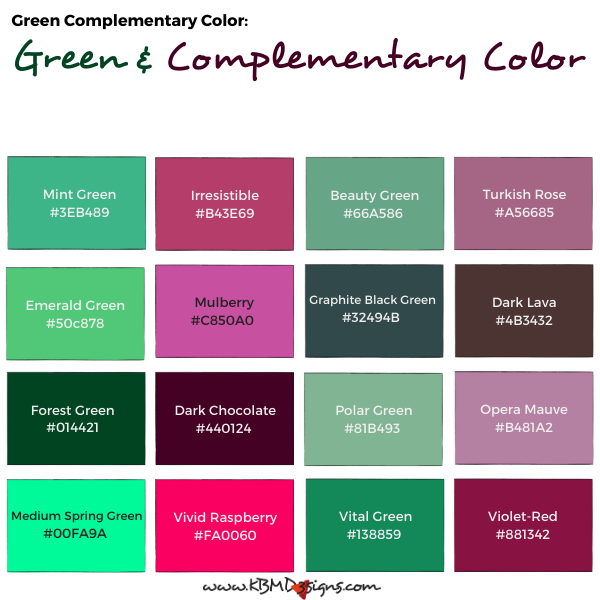
Mint Green #3EB489 – Irresistible #B43E69, Beauty Green #66A586 – Turkish Rose #A56685, Emerald Green #50C878 – Mulberry #C850A0, Graphite Black Green #32494B – Dark Lava #4B3432, Forest Green #014421 – Dark Chocolate #440124, Polar Green #81B493 – Opera Mauve #B481A2, Medium Spring Green #00FA9A – Vivid Raspberry #FA0060, Vital Green #138859 – Violet-Red #881342
A Green Color Palette
The green color palette is vast and diverse, ranging from warm greens to cool greens, and everything in between. Warm greens tend to have more yellow undertones, while cool greens usually have more blue undertones. Some of the most popular shades of green (#008000) include olive green (#808000), forest green (#014421), emerald green (#50C878), mint green (#3EB489), and sage green (#BCB88A).
KBM D3signs uses color tools to match colors and create color schemes.
Warm Green
Warm greens are perfect for creating a cozy and inviting atmosphere in a space. They are often used in living rooms and bedrooms, where people want to feel relaxed and comfortable. One of the best ways to use warm greens in interior design is by pairing them with neutral colors like beige, cream, and white. This creates a calming effect, while still adding a pop of color to the space.

Cool Green
Cool greens, on the other hand, tend to create a more tranquil and refreshing atmosphere. Bathrooms and kitchens top the list, as a place where people want to feel refreshed and rejuvenated. When using cool greens in interior design, it’s best to pair them with other cool colors like blue and purple. This creates a harmonious and calming effect that is perfect for the creation of a serene atmosphere.
Colors That Go With Green
Green is a versatile color that can be paired with a variety of other colors. Some of the most popular green color combinations include green and blue, green and gray, green and yellow, green and orange, green and pink. Additionally, popular are also the neutral combinations of green and white, and green and black.
Green Color Combinations
- Orange and green wall decor and throw pillows
- Pink and green art prints and set of two pillows
- Blue and green horizontal wall panels and a set of 2 pillows
- Green and white throw pillow
- Yellow and green home decor
- Green and grey cushions
It’s important to choose colors that complement rather than clash when using KBM D3signs green, green and white, or green and black patterned throw pillows in interior design projects. This creates a cohesive and harmonious look that is pleasing to the eye.
What Does Green Color Mean?
Green has many associations with growing, harmonizing, and balancing. It is also a color that often has associations with nature, which is a symbol of life and renewal. Psychologists say green has a calming effect on the mind and body. A fact that makes it a popular color choice for healthcare facilities and spas. It is also said to promote a sense of balance and stability, which is why it is often used in corporate environments.
Green as a Symbol
In addition to its practical applications in interior design, green is also a symbol of many things. In nature, it is a symbol of growth and renewal. Some cultures also see it as a symbol of good luck and prosperity. For example in Christianity, it is a symbol of resurrection and eternal life. Associated with love and compassion, it is also the color of the heart chakra.
Different Shades of Green Color in Short
Overall, different shades of green color are versatile and often used in a variety of interior design styles. From warm greens to cool greens, there are many shades of green to choose from. Each can create a different mood and atmosphere in a room. By understanding the psychological effects of green and its practical applications in interior design, you can create a space that is both aesthetically pleasing and promotes a sense of balance and harmony. Whether you want to create a cozy, inviting atmosphere or a refreshing, calming environment, green can help you achieve your design goals. So consider incorporating different shades of green into your next interior design project and see how it can transform your space.
Frequently Asked Questions (FAQs) Different Shades of Green in Interior Design
There are numerous shades of green to choose from, ranging from warm greens like olive and sage to cool greens like mint and teal. These variations offer a wide spectrum of options to suit various design preferences.
The color green has a versatile range of psychological effects. Warmer greens can create a cozy and inviting atmosphere, while cooler greens promote a refreshing and calming environment. The choice of shade can significantly impact the mood and vibe of a space.
Yes, green is unbelievably versatile and can work in a variety of interior design styles, including modern, traditional, eclectic and others. Its adaptability makes it a great choice for any design concept.
To use different shades of green effectively, start by considering your design goals. Choose a shade that aligns with the mood you want to create and pair it with complementary colors and materials. You can use green on walls, furniture, decor items, or as accents to achieve the desired effect.
Green pairs well with various colors, including neutrals like beige and gray for a sophisticated look. It also works beautifully with complementary colors such as coral or navy blue for a striking contrast. Experimenting with different combinations can yield stunning results.
-
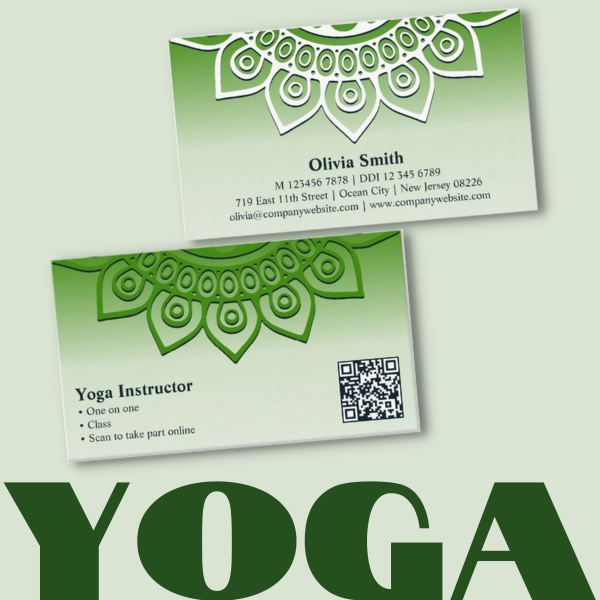
Green Business Cards and Their Professional Appeal
Read the post …: Green Business Cards and Their Professional Appeal -
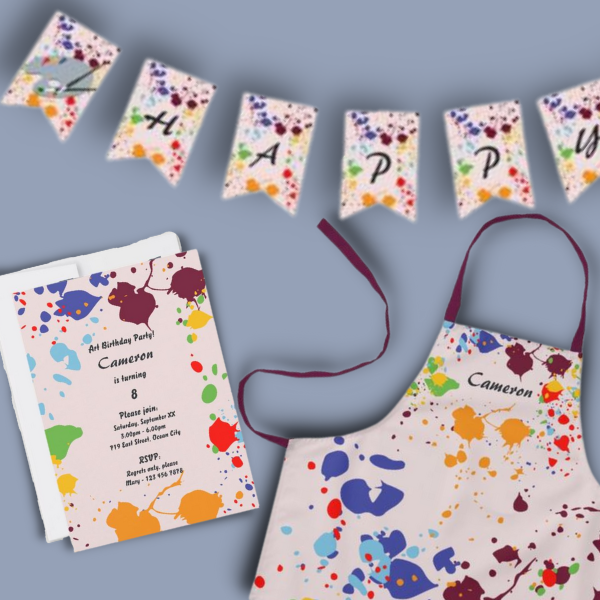
A Kids Painting Birthday Party at Home Makes Unforgettable Fun
Read the post …: A Kids Painting Birthday Party at Home Makes Unforgettable Fun -
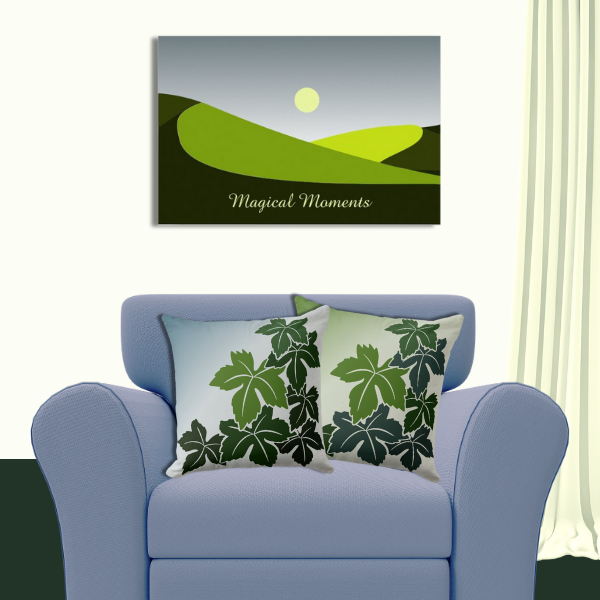
Blue and Green Wall Art, Enchanting Allure in Home Decor
Read the post …: Blue and Green Wall Art, Enchanting Allure in Home Decor -
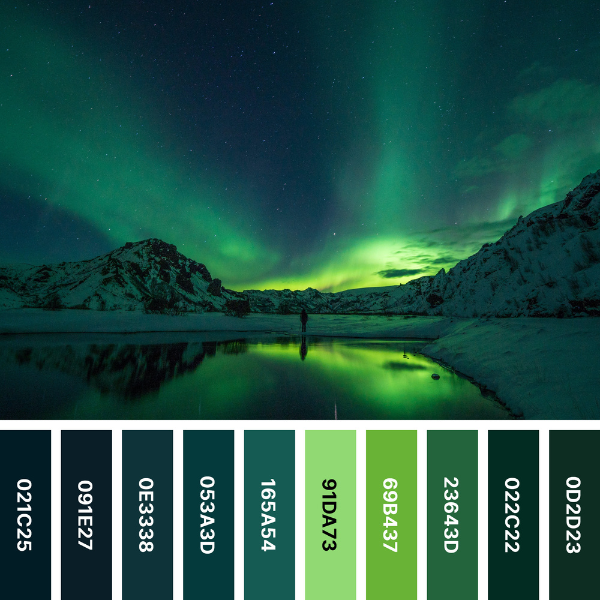
Blue and Green Color Palette Unleashing Its Beauty in Your Home
Read the post …: Blue and Green Color Palette Unleashing Its Beauty in Your Home -
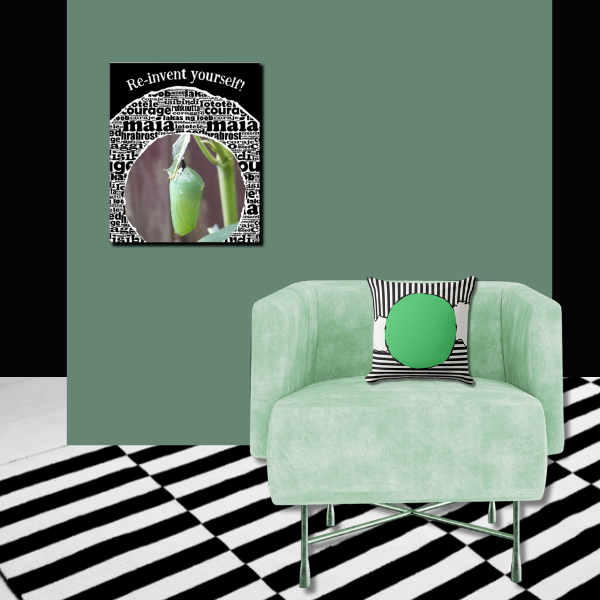
Black and Green Wall Art to Enhance Your Home Decor
Read the post …: Black and Green Wall Art to Enhance Your Home Decor -
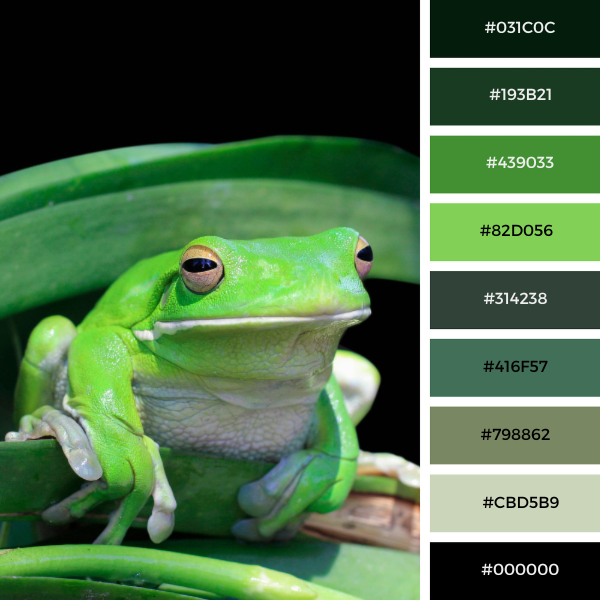
A Striking Black and Green Color Palette to Elevate Your Home Decor
Read the post …: A Striking Black and Green Color Palette to Elevate Your Home Decor


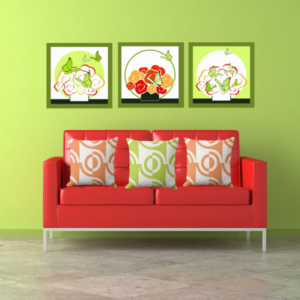

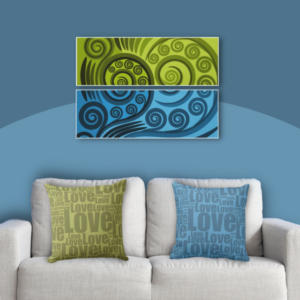
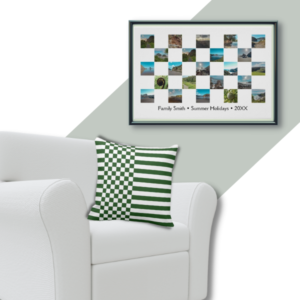


What a stuff of un-ambiguity and preserveness of valuable experience on the topic of unexpected feelings.
Thank you for your thoughtful comment! I’m glad to hear that you found the content clear and valuable, especially on such a nuanced topic. It’s always rewarding to know that the information shared resonates with readers. If you have any further thoughts or questions on the subject, feel free to share. Your engagement is much appreciated!
Howdy! This article couldn’t be written any better!
Looking at this article reminds me of my previous roommate!
He constantly kept preaching about this. I mot
certainly will send this information to him.
Pretty sure he will have a good read. Thanks for
sharing!
Hi! Thank you so much for your wonderful feedback! I’m glad to hear that the article resonated with you and reminded you of your previous roommate. It’s great to know that it brought back good memories. Feel free to share the information with him – I hope he enjoys the read as much as you did. Thanks for taking the time to share your thoughts and for spreading the word!
Greetings from Los Angeles! I’m bored to death at work so
I decided to check out your site on my iPhone during lunch break.
I really like the knowledge you provide here and can’t wait
to take a look when I get home. I’m surprised at how fast your blog loaded on my cell phone.
I’m not even using WIFI, just 3G. Anyways, good site!
Hello from the other side of the country! I’m glad you decided to check out my site during your lunch break – it’s always nice to provide a little distraction from the workday. I’m thrilled to hear that you like the knowledge provided here and that you’re excited to explore more when you get home. It’s great to know that the blog loaded quickly on your cell phone, even without WIFI. That’s fantastic feedback about the site’s mobile responsiveness! If there’s anything specific you’re looking forward to reading about or if you have any suggestions, feel free to let me know. Thank you for taking the time to visit the site, and I hope it continues to be a source of enjoyment and information for you!
You are in reality a good webmaster. The site loading pace is incredible.
It sort of feels that you are doing any unique trick.
Also, the contents are masterwork. you’ve done a magnificent job on this subject!
Thank you so much for your kind words! I’m thrilled to hear that you’re impressed with the site’s loading speed and content quality. I strive to ensure a seamless user experience and provide valuable insights into interior design topics. Your feedback is truly motivating, and it’s wonderful to know that you find the contents to be masterful. If there are any specific areas or topics you’d like to see covered in more depth in the future, please feel free to let me know. Thanks again for your support, and I’m glad you’re enjoying the content!
Excellent article. Keep writing such kind of information on your page.
I’m really impressed by your blog.
Hey there, You have performed an incredible job.
I will certainly Digg it and individually recommend to my friends.
I am sure they will be benefited from this website.
Thank you so much for your kind words and encouragement! I’m thrilled to hear that you found the article excellent and that you’re impressed with the content on my blog. I appreciate your support and am grateful for your recommendation to your friends. If there’s anything specific you’d like to see in future articles or if you have any questions, feel free to let me know. Cheers, and thanks again for your positive feedback!
Hi to all, how is everything, I think every one is getting more from this web site, and your views are pleasant in favor of new people.
Hello there! I’m glad to hear that you’re enjoying the content on this web site. It’s always great to know that the views and information are resonating well, especially for newcomers. If there’s anything specific you’d like to see more of or if you have any questions, feel free to let me know. Your positive feedback is much appreciated, and I hope you continue to find valuable insights here. Cheers!
This is a topic which is close to my heart… Cheers!
Where are your contact details though?
I’m delighted to hear that the topic resonates with you! Cheers indeed! If you’re looking to get in touch, you can find my contact details on the contact page of my website. Feel free to reach out, and I’d be happy to connect with you. Here’s the direct link to the contact page: https://kbmd3signs.com/contact/#contact. Looking forward to hearing from you!
I am really impressed with your writing skills as well as with the layout on your blog.
Is this a paid theme or did you modify it yourself? Either way keep up the nice quality writing, it’s
rare to see a nice blog like this one nowadays.
Thank you for your kind words! I’m glad you’re impressed with the writing and the layout of my blog. To clarify, the theme I’m using is a modified free WordPress theme from 2017. While it’s not a paid theme, I’ve made some personal modifications to tailor it to my preferences.
I believe in the importance of providing quality content in an aesthetically pleasing manner. If you have any specific questions about the theme or if there’s anything else you’d like to know, feel free to ask. I appreciate your positive feedback, and I’m dedicated to maintaining the standard of quality on the blog.
I do not even know the way I finished up here, however I assumed this put up used to be great.
I don’t recognise who you’re but certainly you’re going to a well-known blogger in case you aren’t already.
Cheers!
Thank you so much for your kind words! I’m thrilled that you enjoyed the post. It’s always wonderful to hear positive feedback. I appreciate your assumption, and while I may not be a well-known blogger yet, I’m here to share valuable content and engage with a fantastic audience.
If you have any questions or if there’s a specific topic you’d like to see covered, feel free to let me know. Cheers to you as well, and I’m grateful for your visit and encouraging words!
Hola! I’ve been reading your weblog for a while
now and finally got the courage to go ahead and give you a shout out
from Porter Tx! Just wanted to tell you keep up
the fantastic job!
¡Hola! Muchas gracias for taking the time to read my weblog, and I truly appreciate the shout-out from Porter, Tx! It means a lot to hear that you’ve been following my content. I’m glad to have your support, and I’ll definitely do my best to keep up the fantastic job.
If there’s ever anything specific you’d like to see or discuss on the blog, feel free to let me know. Your feedback is valuable, and I’m here to provide content that you find interesting and useful. ¡Gracias nuevamente y saludos desde donde estés en Porter, Tx!
Great post. I was checking constantly this blog and I am impressed!
Very helpful info specifically the last part 🙂 I care for such information a lot.
I was seeking this particular information for a very long time.
Thank you and best of luck.
Thank you so much for your kind words! I’m thrilled to hear that you found the post helpful, and I appreciate your continuous support. It’s always rewarding to know that the information shared resonates with readers like you.
If you ever have more questions or if there’s anything specific you’d like to see in future posts, feel free to let me know. Best of luck to you as well, and thanks again for stopping by and taking the time to share your feedback!
Hello there! This is my first visit to your blog! We are a collection of volunteers and starting
a new project in a community in the same niche.
Your blog provided us beneficial information to work on. You have done a marvellous job!
Hello and welcome! I’m delighted to hear that you and your team found valuable information on my blog for your new community project. It’s fantastic to see a group of volunteers coming together to embark on a common goal within the same niche.
If there’s anything specific you need assistance with or if you have any questions along the way, feel free to reach out. Best of luck with your project, and I hope it brings positive impact and success to your community. Thank you for your kind words, and I’m glad my blog could contribute to your endeavors!
Today, while I was at work, my cousin stole my iPad and tested to see if it can survive a 30
foot drop, just so she can be a youtube sensation. My apple ipad is now broken and she has 83 views.
I know this is totally off topic but I had to
share it with someone!
Oh no, that sounds like quite an unexpected and unfortunate experience with your iPad! It’s always surprising how these unexpected situations can happen. On the bright side, it seems like your cousin’s daring experiment at least gained some attention with 83 views on YouTube.
Feel free to share your tech woes here – sometimes sharing these off-topic stories can be a good way to lighten the mood. If you’re looking for advice on fixing or replacing your iPad, I’m sure the community here would be happy to help with suggestions. And who knows, maybe your cousin’s unintentional YouTube debut will become a funny story to look back on!
Whats up are using WordPress for your site platform?
I’m new to the blog world but I’m trying to get started and set up
my own. Do you require any coding expertise to make your own blog?
Any help would be greatly appreciated!
Hey there! Welcome to the exciting world of blogging! Yes, I’m using WordPress for my site platform, and it’s a fantastic choice for both beginners and experienced bloggers. The best part is, you don’t necessarily need coding expertise to set up your own blog on WordPress.
WordPress offers a user-friendly interface and plenty of customizable themes and plugins that make it easy to create a unique and professional-looking blog without diving into complex coding. You can start by choosing a theme that suits your style and then customize it through the WordPress dashboard.
However, having some basic understanding of HTML and CSS can be helpful for more advanced customization. But don’t worry if you’re not familiar with coding – there are plenty of online resources, tutorials, and forums where you can find support and guidance.
If you ever have specific questions or run into challenges, feel free to ask. The blogging community is generally very supportive, and there’s always someone willing to help. Best of luck with your new blog adventure!
Hey There. I found your blog the use of msn. That is a very well written article.
I will make sure to bookmark it and come back to learn extra of
your useful info. Thanks for the post. I will
definitely return.
Hello! Thank you so much for your kind words and for taking the time to explore my blog. I’m thrilled to hear that you found the article well-written and valuable. Your support means a lot, and I’m delighted that you’re planning to return for more useful information. If you have any specific topics or questions you’d like me to cover in future posts, feel free to let me know. Looking forward to having you back!
Simply want to say your article is as surprising.
The clearness in your post is simply great and i
can assume you are an expert on this subject. Fine with your permission let me to grab your
RSS feed to keep up to date with forthcoming post. Thanks a million and please continue the rewarding work.
Thank you so much for your kind words! I’m thrilled to hear that you found the article surprising and valuable. I’m passionate about exploring the nuances of color psychology in interior design, and I’m glad it came through in the clarity of the post. Feel free to grab the RSS feed to stay updated on forthcoming content – your support means a lot. If you have any specific topics or questions you’d like me to cover in the future, please don’t hesitate to let me know. Thanks again for your encouragement!
Simply desire to say your article is as astounding.
The clearness in your post is simply excellent and i could assume you are an expert on this subject.
Well with your permission allow me to grab your feed
to keep updated with forthcoming post. Thanks a million and please keep up
the enjoyable work.
Also visit my web site; https(:)//socialbookmark.stream/story.php?title=ubon-on-a-budget-affordable-car-rental-options-for-travelers and discuss.
Thank you so much for your kind words and positive feedback on the article! We’re delighted to hear that you found the content informative and well-presented. It’s always our goal to provide valuable insights and information to our readers.
You’re more than welcome to subscribe to our feed to stay updated on forthcoming posts. We appreciate your interest and look forward to continuing to provide you with enjoyable and informative content on interior design and related topics.
If you have any specific questions or topics you’d like to see covered in future articles, please don’t hesitate to let us know. Thanks again for your support!